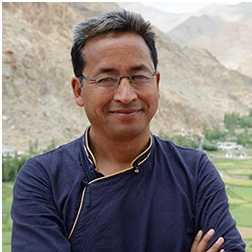Magsaysay awardee Sonam solves Army’s winter woes
Date:- 07 Jan 2019

Azhar Qadri
An award-winning innovator from the remote Ladakh region has found the answer to the Army’s winter worry by preparing a prototype hut which taps solar energy and increases the room temperature by nearly 40°C.
Sonam Wangchuk, the Ramon Magsaysay Award winner and a celebrated innovator and engineer, solved the Army’s struggle with the arctic climatic conditions of Ladakh by going back to the “ancient method” of using straw and clay for the construction of bunkers and residential quarters.
“We only attuned the ratio of clay and straw to make it more insulated for better heating and light weight for easy transportation,” Wangchuk told The Tribune over the phone from Ladakh.
He said the Army had shown “more than just interest” in his prototype solar-heated huts which would “not require any other energy” and also ease the pressure on the environment by cutting on pollution-causing methods of heating.
The Ladakh region, where an Army Corps is stationed on two frontiers with Pakistan and China, is one of the coldest places of the world and also home to the second-coldest inhabited town, Drass, where the lowest recorded temperature was -60°C on January 9, 1995.
The solar-heated hut will allow sunlight inside and use straw-clay walls to tap it, having the potential to create a temperature gap of up to 40°C
“If the outside temperature will be -20°C, inside the hut it will be 20°C,” Wangchuk said.
The celebrated innovator, whose life story inspired Bollywood blockbuster ‘3 Idiots’, said the idea of building huts of pre-fabricated bricks of clay and straw -- which he described as fibre-reinforced clay for housing purposes, was initially used to solve the problems of people in Ladakh who faced rigid climatic conditions which shortened the work period to a few months and also made it labour cheap.
The Army, Wangchuk said, had approved the prototypes to solve its trouble with the freezing weather in Ladakh, where soldiers guarded a mountainous frontier throughout the year, even when the temperatures routinely dropped 20°C to 30°C below the freezing point in the winter. “They want us to build more…we hope to be ready with low production this summer and may be fully by the next summer,” Wangchuk said.
Courtesy:The Tribune,Jan07,2018


